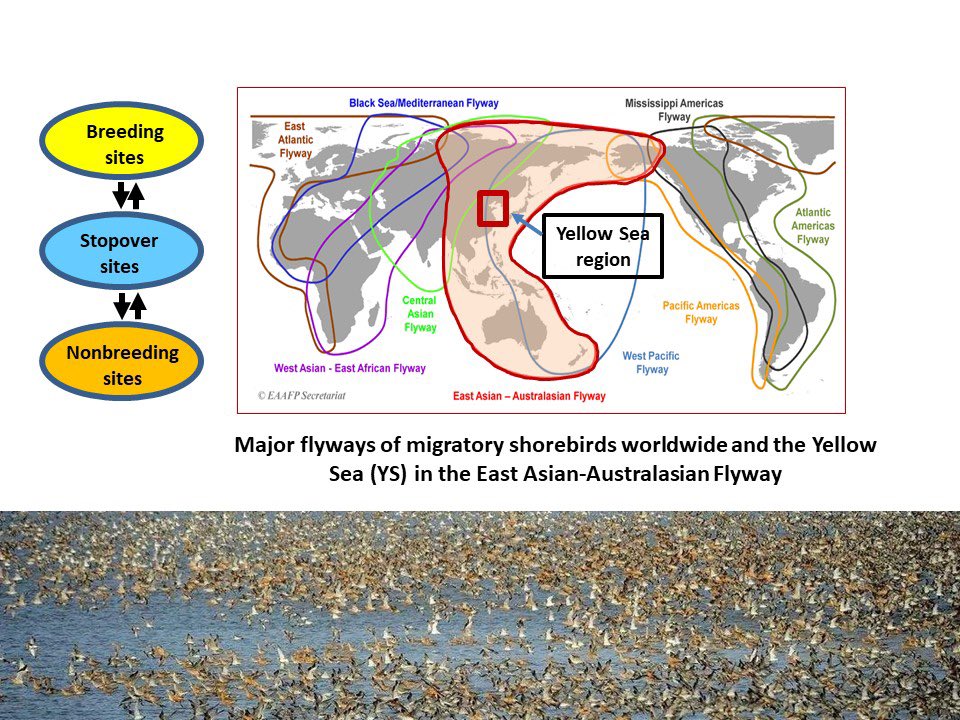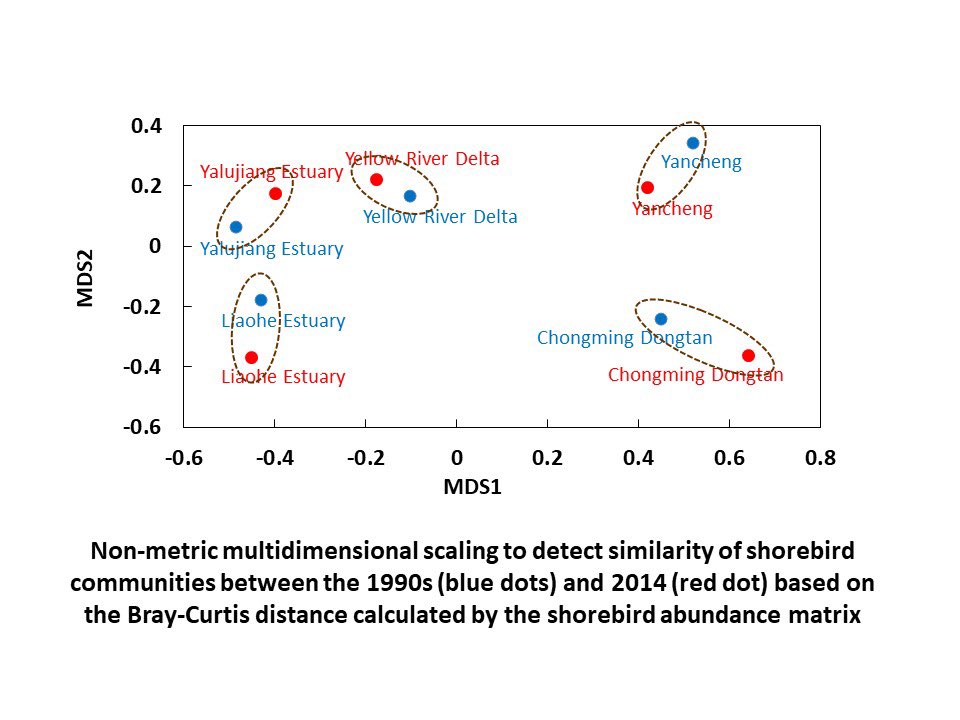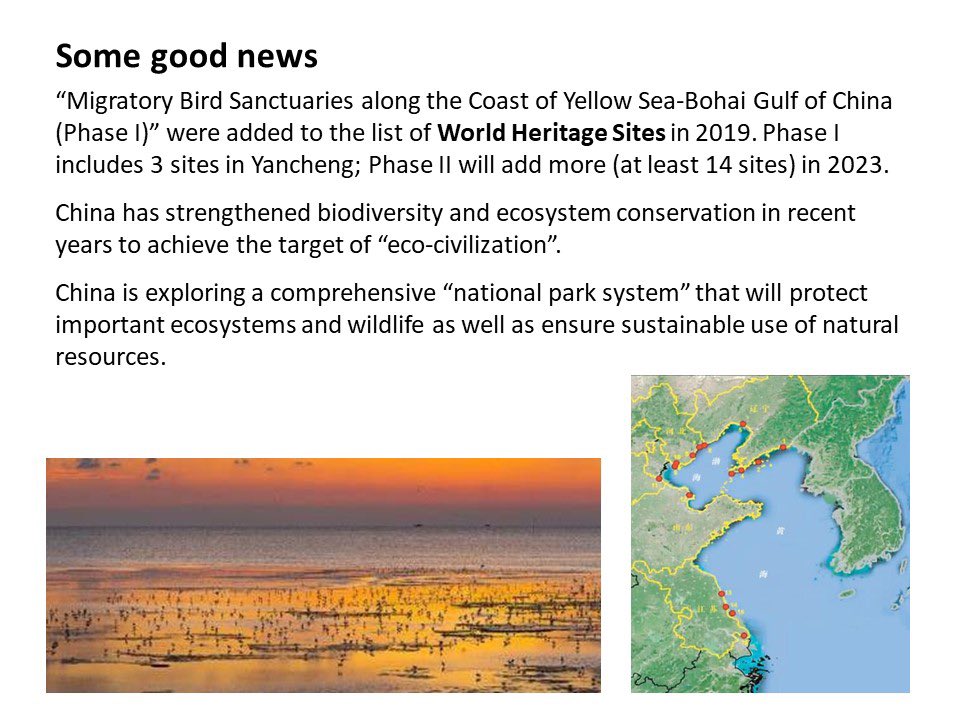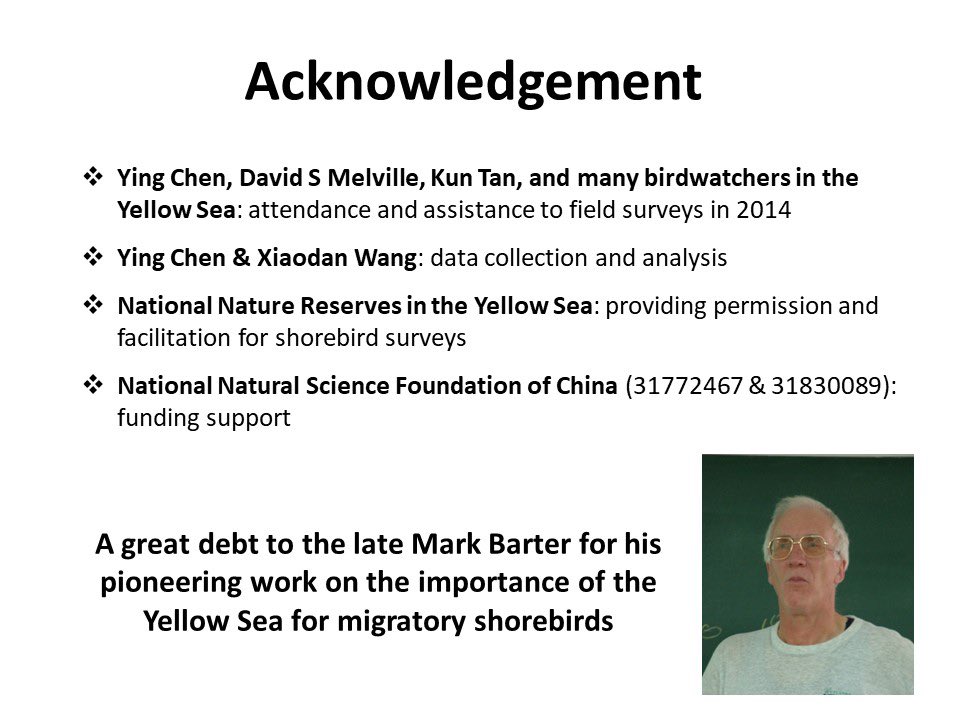
1 #ISTC20 #Sesh1 #ornithology Hello everyone. Thanks for the organizer of ISTC and Ryan. You can find my detailed information at researchgate.net/profile/Zhijun…. It’s my great honor to share the study of my team on shorebirds and their habitats in the Yellow Sea in China. 

2 #ISTC20 #Sesh1 Migratory shorebirds depend on the linkage of breeding, nonbreeding, and stopover sites between them to maintain their population. The Yellow Sea (YS) region provides critical stopover sites for migratory shorebirds in the East Asian-Australasian Flyway (EAAF). 

3 #ISTC20 #Sesh1 The Yellow Sea (YS), including Bohai Bay in the northwest, is surrounded by Chinese mainland and Korea Peninsular. It has the largest tidal wetland (more than 10,000 km2) worldwide. 

4 #ISTC20 #Sesh1 The (Inter)tidal wetland is the critical habitat for migratory shorebirds in the YS. The importance of tidal wetland in the YS for migratory shorebirds has been well exhibited over the past 30 years. 

5 #ISTC20 #Sesh1 Unfortunately, tidal wetlands have suffered dramatic loss in the YS over the past decades, mainly due to land reclamation. Many studies have indicated that tidal wetland loss in the YS is the major cause of rapid population decline of shorebirds in the EAAF. 

6 #ISTC20 #Sesh1 Protected areas are the cornerstone of biodiversity conservation. Protected areas expand rapidly worldwide and greatly contribute to the protection of threatened species and their habitats. 

7 #ISTC20 #Sesh1 Many nature reserves (protected areas mainly for conservation target) have been established in the YS, China, including 14 national nature reserves (NNRs), the most strictly protected nature reserves. 

8 #ISTC20 #Sesh1 Here we want to detect: what about the function of nature reserves in conserving shorebirds and their tidal wetland habitats in the YS? You can find the published paper @ConBiology about the 1st question on slide at doi.org/10.1111/cobi.1… 

9 #ISTC20 #Sesh1 We used official data to detect the changes of number and area of NNRs. To detect tidal wetland changes, we used TM and ETM+ images in Google Earth. We extracted artificial shorelines and the lowest tidelines; the region between them was used as tidal wetlands. 

10 #ISTC20 #Sesh1 Along with the designation of new NNRs, the total number of NNRs kept increasing since the 1980s. However, the total area of NNRs decreased after 2006. The decrease in area of NNRs was due to the boundary adjustment, which caused downsize of NNRs. 

11 #ISTC20 #Sesh1 Boundary adjustment excluded 453000 ha of enclosed land and added 13800 ha of tidal wetlands to NNRs as well as removed 51200 ha of tidal wetlands from NNRs. Overall, tidal wetlands in the NNRs decreased by 48% from the time of designation of the NNRs to 2015. 

12 #ISTC20 #Sesh1 Tidal wetlands in NNRs had a net loss of 32% from 2000-2015, similar with the loss of tidal wetland area outside NNRs (35%). Although the number of NNRs increased, the proportion of tidal wetland area in NNRs of the total in the YS remained stable from 1990-2015 

13 #ISTC20 #Sesh1 Similar individuals and species were recorded between the surveys in the five NNRs: a total of 327803 birds in 41 species were recorded in 2014, comparing with 356283 birds in 43 species in 1990s. Individual numbers largely changed (range -62%~+99%) in each NNR. 

14 #ISTC20 #Sesh1 Changes in shorebirds number between the surveys was not significantly related to the areal changes of tidal wetland. There was no significant relationship between tidal wetland loss and shorebird number changes during the periods at 14 sites in the YS. 

15 #ISTC20 #Sesh1 Although shorebird numbers dramatically changed, the dominant species were generally consistent in each NNR between the periods. 

16 #ISTC20 #Sesh1 Species that meet the 1% criteria of international importance were generally consistent in each NNR between the periods. 

17 #ISTC20 #Sesh1 Although tidal wetland area and bird numbers changed dramatically, species composition was similar in each NNR between the periods. This suggests high stability in bird communities, which might be closely related to the habitat and food condition at each site. 

18 #ISTC20 #Sesh1 For example, both red and great knots mainly consume bivalves in YS. The smaller sized Red knots are dominant at Nanpu where there are small-sized bivalves, while the larger sized great knots are dominant at Yalujiang estuary where there are large-sized bivalves 

19 #ISTC20 #Sesh1 Because shorebirds that depend on tidal wetlands in the YS have suffered rapid population declines, our results suggest that loss of tidal wetlands has pushed shorebirds aggregating at the remaining habitat in the YS. 

20 #ISTC20 #Sesh1 There are some good news for the conservation of shorebirds and their habitats. The nomination of the YS as World Heritage Site is a good opportunity for conservation. 

21 #ISTC20 #Sesh1 In conclusion, effective measures are urgently required to improve shorebird conservation along the EAAF. 

• • •
Missing some Tweet in this thread? You can try to
force a refresh



